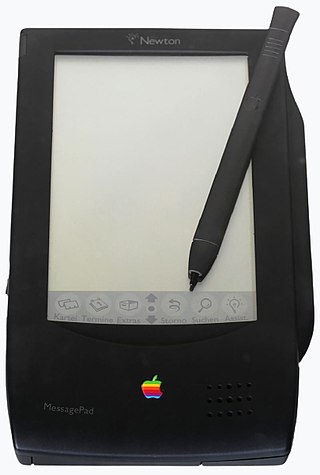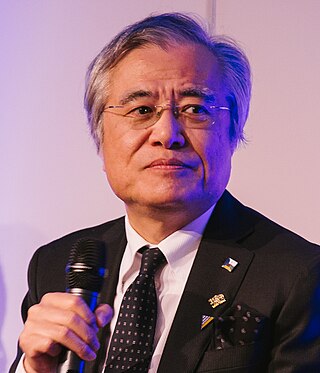
The MessagePad is a series of personal digital assistant devices developed by Apple Computer for the Newton platform, first released in 1993. Some electronic engineering and the manufacture of Apple's MessagePad devices was undertaken in Japan by Sharp. The devices are based on the ARM 610 RISC processor, run Newton OS, and all feature handwriting recognition software. Alongside the MessagePad series, Apple also developed and released the eMate 300 Newton device.
Java Platform, Micro Edition or Java ME is a computing platform for development and deployment of portable code for embedded and mobile devices. Java ME was formerly known as Java 2 Platform, Micro Edition or J2ME.
Reconfigurable computing is a computer architecture combining some of the flexibility of software with the high performance of hardware by processing with flexible hardware platforms like field-programmable gate arrays (FPGAs). The principal difference when compared to using ordinary microprocessors is the ability to add custom computational blocks using FPGAs. On the other hand, the main difference from custom hardware, i.e. application-specific integrated circuits (ASICs) is the possibility to adapt the hardware during runtime by "loading" a new circuit on the reconfigurable fabric, thus providing new computational blocks without the need to manufacture and add new chips to the existing system.

The Nippon Telegraph and Telephone Corporation (NTT) is a Japanese telecommunications holding company headquartered in Tokyo, Japan. Ranked 55th in Fortune Global 500, NTT is the fourth largest telecommunications company in the world in terms of revenue, as well as the third largest publicly traded company in Japan after Toyota and Sony, as of June 2022. In 2023, the company was ranked 56th in the Forbes Global 2000.

Ken Sakamura, as of April 2017, is a Japanese professor and dean of the Faculty of Information Networking for Innovation and Design at Toyo University, Japan. He is a former professor in information science at the University of Tokyo. He is the creator of the real-time operating system (RTOS) architecture TRON.

Mobile computing is human–computer interaction in which a computer is expected to be transported during normal usage and allow for transmission of data, which can include voice and video transmissions. Mobile computing involves mobile communication, mobile hardware, and mobile software. Communication issues include ad hoc networks and infrastructure networks as well as communication properties, protocols, data formats, and concrete technologies. Hardware includes mobile devices or device components. Mobile software deals with the characteristics and requirements of mobile applications.
OMA SpecWorks, previously the Open Mobile Alliance (OMA), is a standards organization which develops open, international technical standards for the mobile phone industry. It is a nonprofit Non-governmental organization (NGO), not a formal government-sponsored standards organization as is the International Telecommunication Union (ITU): a forum for industry stakeholders to agree on common specifications for products and services.
A Rich Internet Application is a web application that has many of the characteristics of desktop application software. The concept is closely related to a single-page application, and may allow the user interactive features such as drag and drop, background menu, WYSIWYG editing, etc. The concept was first introduced in 2002 by Macromedia to describe Macromedia Flash MX product. Throughout the 2000s, the term was generalized to describe browser-based applications developed with other competing browser plugin technologies including Java applets, Microsoft Silverlight.

The history of mobile phones covers mobile communication devices that connect wirelessly to the public switched telephone network.

United Devices, Inc. was a privately held, commercial volunteer computing company that focused on the use of grid computing to manage high-performance computing systems and enterprise cluster management. Its products and services allowed users to "allocate workloads to computers and devices throughout enterprises, aggregating computing power that would normally go unused." It operated under the name Univa UD for a time, after merging with Univa on September 17, 2007.
Grid MP is a commercial distributed computing software package developed and sold by Univa, a privately held company based primarily in Austin, Texas. It was formerly known as the MetaProcessor prior to the release of version 4.0, however the letters MP in Grid MP do not officially stand for anything.

The Trusted Computing Group is a group formed in 2003 as the successor to the Trusted Computing Platform Alliance which was previously formed in 1999 to implement Trusted Computing concepts across personal computers. Members include Intel, AMD, IBM, Microsoft, and Cisco.

Cloud computing is the on-demand availability of computer system resources, especially data storage and computing power, without direct active management by the user. Large clouds often have functions distributed over multiple locations, each of which is a data center. Cloud computing relies on sharing of resources to achieve coherence and typically uses a pay-as-you-go model, which can help in reducing capital expenses but may also lead to unexpected operating expenses for users.

NTT Data Payment Services is a payment services provider company headquartered in Mumbai, India.

Symbian was a mobile operating system (OS) and computing platform designed for smartphones. It was originally developed as a proprietary software OS for personal digital assistants in 1998 by the Symbian Ltd. consortium. Symbian OS is a descendant of Psion's EPOC, and was released exclusively on ARM processors, although an unreleased x86 port existed. Symbian was used by many major mobile phone brands, like Samsung, Motorola, Sony Ericsson, and above all by Nokia. It was also prevalent in Japan by brands including Fujitsu, Sharp and Mitsubishi. As a pioneer that established the smartphone industry, it was the most popular smartphone OS on a worldwide average until the end of 2010, at a time when smartphones were in limited use, when it was overtaken by iOS and Android. It was notably less popular in North America.
P2P Universal Computing Consortium (PUCC) is promoting research and development of an open P2P/Overlay network service platform that connects multi-types of devices users use, and conducts the standardization efforts. PUCC is a cross-industry consortium for open P2P/Overlay network standards. PUCC operations are supported by a combination of membership dues and public grants.
Lumitrend, Inc. was a mobile software development firm founded in 2002 by Rob Meadows and Garrett Larsson, and was based in San Mateo, California. The company developed one of the first commercially available solutions to automatically and wirelessly backup a user's cell phone data including contacts, calendar, pictures, ring tones, wallpaper, and videos. The Intersynx technology platform utilized J2ME and Brew based technology and included products such as RingVault, CellBackup and CellSynx.
Heterogeneous computing refers to systems that use more than one kind of processor or core. These systems gain performance or energy efficiency not just by adding the same type of processors, but by adding dissimilar coprocessors, usually incorporating specialized processing capabilities to handle particular tasks.
Multi-access edge computing (MEC), formerly mobile edge computing, is an ETSI-defined network architecture concept that enables cloud computing capabilities and an IT service environment at the edge of the cellular network and, more in general at the edge of any network. The basic idea behind MEC is that by running applications and performing related processing tasks closer to the cellular customer, network congestion is reduced and applications perform better. MEC technology is designed to be implemented at the cellular base stations or other edge nodes, and enables flexible and rapid deployment of new applications and services for customers. Combining elements of information technology and telecommunications networking, MEC also allows cellular operators to open their radio access network (RAN) to authorized third parties, such as application developers and content providers.
An AI accelerator, deep learning processor or neural processing unit (NPU) is a class of specialized hardware accelerator or computer system designed to accelerate artificial intelligence and machine learning applications, including artificial neural networks and computer vision. Typical applications include algorithms for robotics, Internet of Things, and other data-intensive or sensor-driven tasks. They are often manycore designs and generally focus on low-precision arithmetic, novel dataflow architectures or in-memory computing capability. As of 2024, a typical AI integrated circuit chip contains tens of billions of MOSFETs.









